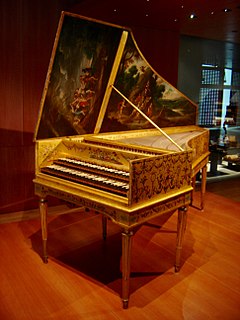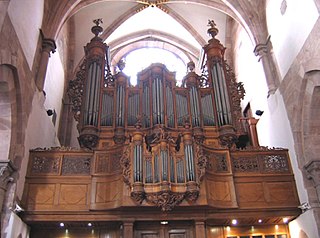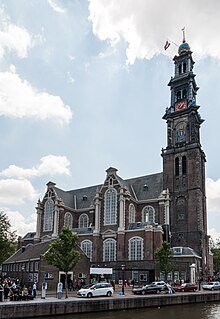
The clavichord is a Western European stringed rectangular keyboard instrument that was used largely in the Late Middle Ages, through the Renaissance, Baroque and Classical eras. Historically, it was mostly used as a practice instrument and as an aid to composition, not being loud enough for larger performances. The clavichord produces sound by striking brass or iron strings with small metal blades called tangents. Vibrations are transmitted through the bridge(s) to the soundboard.

A harpsichord is a musical instrument played by means of a keyboard. Like a pipe organ, a harpsichord may have more than one keyboard manual and harpsichords may have stop buttons which add or remove additional octaves. Some harpsichords may have a lute stop, which simulates the sound of a plucked lute. This activates a row of levers that turn a trigger mechanism that plucks one or more strings with a small plectrum made from quill or plastic. The strings are under tension on a soundboard, which is mounted in a wooden case; the soundboard amplifies the vibrations from the strings so that the listeners can hear it.

The pipe organ is a musical instrument that produces sound by driving pressurized air through the organ pipes selected from a keyboard. Because each pipe produces a single pitch, the pipes are provided in sets called ranks, each of which has a common timbre and volume throughout the keyboard compass. Most organs have many ranks of pipes of differing timbre, pitch, and volume that the player can employ singly or in combination through the use of controls called stops.

In music, the organ is a keyboard instrument of one or more pipe divisions or other means for producing tones, each played with its own keyboard, played either with the hands on a keyboard or with the feet using pedals.

The Westerkerk is a Reformed church within Dutch Protestant Calvinism in central Amsterdam, Netherlands. It lies in the most western part of the Grachtengordel neighborhood, next to the Jordaan, between the Prinsengracht and Keizersgracht.

A pedalboard is a keyboard played with the feet that is usually used to produce the low-pitched bass line of a piece of music. A pedalboard has long, narrow lever-style keys laid out in the same semitone scalar pattern as a manual keyboard, with longer keys for C, D, E, F, G, A and B, and shorter, higher keys for C♯, D♯, F♯, G♯ and A♯. Training in pedal technique is part of standard organ pedagogy in church music and art music.

A manual is a musical keyboard designed to be played with the hands, on an instrument such as a pipe organ, harpsichord, clavichord, electronic organ, melodica, or synthesizer. The term "manual" is used with regard to any hand keyboard on these instruments to distinguish it from the pedalboard, which is a keyboard that the organist plays with their feet. It is proper to use "manual" rather than "keyboard", then, when referring to the hand keyboards on any instrument that has a pedalboard.
Georg Böhm was a German Baroque organist and composer. He is notable for his development of the chorale partita and for his influence on the young J. S. Bach.
The Eight Short Preludes and Fugues, BWV 553–560, are a collection of works for keyboard and pedal formerly attributed to Johann Sebastian Bach. They are now believed to have been composed by one of Bach's pupils, possibly Johann Tobias Krebs or his son Johann Ludwig Krebs.
Gottfried Silbermann was a German builder of keyboard instruments. He built harpsichords, clavichords, organs, and fortepianos; his modern reputation rests mainly on the latter two.

The organ in St. Jacobi Church, Hamburg, was built in 1689 – 1693 by the renowned organ builder Arp Schnitger. The organ boasts four manuals and pedal with 60 stops -- of which 15 are reeds -- and totalling approximately 4000 sounding pipes. All in all, from the organ's original installation and its condition today not much of its conception has changed. The old pipework and the prospect pipes have been preserved in almost original format. This is the largest organ in existence from before 1700 and is one of the most eminent Baroque instruments that have been preserved.

Johann Gottfried Müthel was a German composer and noted keyboard virtuoso. Along with C.P.E. Bach, he represented the Sturm und Drang style of composition.
Susi Jeans born Suzanne Hock (1911–1993), after 1935 also known by virtue of her husband's knighthood as Lady Jeans, was an Austrian-born professional organist, teacher and musicologist.

The pedal piano is a kind of piano that includes a pedalboard, enabling bass register notes to be played with the feet, as is standard on the organ.
Carole Ruth Terry is an American organist, harpsichordist, and pedagogue.

A crescendo pedal is a large pedal commonly found on medium-sized and larger pipe organs, either partially or fully recessed within the organ console. The crescendo pedal incrementally activates stops as it is pressed forward and removes stops as it is depressed backward. The addition of stops, in order from quietest to loudest, creates the effect of a crescendo. The crescendo pedal is located directly above the pedalboard, to the right of any expression pedals that may be present. In actual use, the operation of the crescendo pedal usually does not move the draw knobs or stop tabs on the console; the stops are electronically activated inside the organ. Often an indicator light or lights will be present on the console to inform the organist of when the crescendo pedal is activated and how far it is engaged.

Johann Sebastian Bach was a German composer and musician of the Baroque period. He is known for instrumental compositions such as the Brandenburg Concertos and the Goldberg Variations, and for vocal music such as the St Matthew Passion and the Mass in B minor. Since the 19th-century Bach Revival, he has been generally regarded as one of the greatest composers of all time.

Harald Vogel (1941) is a German organist, organologist, and author. He is a leading expert on Renaissance and Baroque keyboard music. He has been professor of organ at the University of the Arts Bremen since 1994.

The Clavier-Übung III, sometimes referred to as the German Organ Mass, is a collection of compositions for organ by Johann Sebastian Bach, started in 1735–36 and published in 1739. It is considered Bach's most significant and extensive work for organ, containing some of his most musically complex and technically demanding compositions for that instrument.

The organ sonatas, BWV 525–530 by Johann Sebastian Bach are a collection of six sonatas in trio sonata form. Each of the sonatas has three movements, with three independent parts in the two manuals and obbligato pedal. The collection was put together in Leipzig in the late 1720s and contained reworkings of prior compositions by Bach from earlier cantatas, organ works and chamber music as well as some newly composed movements. The sixth sonata, BWV 530, is the only one for which all three movements were specially composed for the collection. When played on an organ, the second manual part is often played an octave lower on the keyboard with appropriate registration. Commentators have suggested that the collection might partly have been intended for private study to perfect organ technique, some pointing out that its compass allows it to be played on a pedal clavichord. The collection of sonatas is generally regarded as one of Bach's masterpieces for organ. The sonatas are also considered to be amongst his most difficult compositions for the instrument.
















